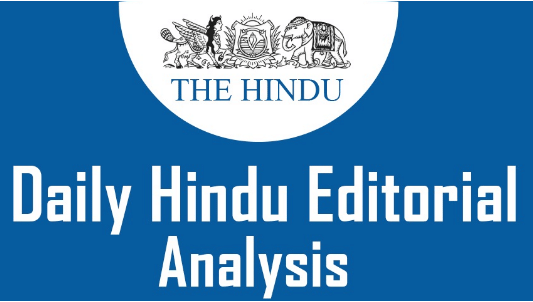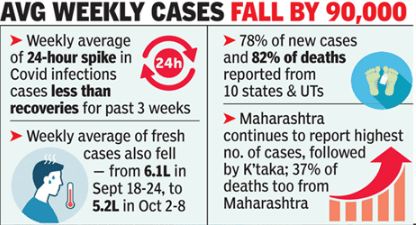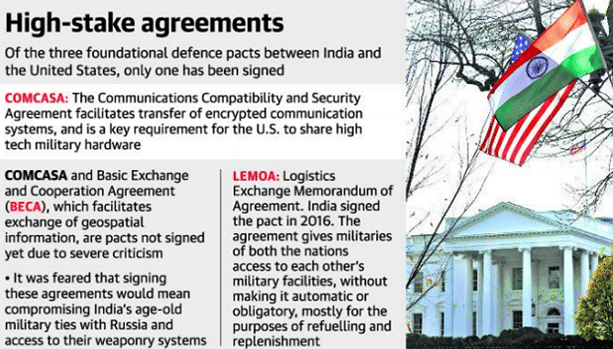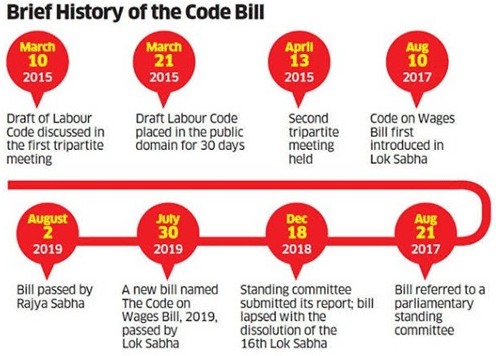The Hindu Editorial Analysis- 2nd November, 2020 | Additional Study Material for UPSC PDF Download

1. SIGNS OF EASING-
GS 2- Issues relating to development and management of Social Sector/Services relating to Health
Context
After reporting over 97,650 novel coronavirus cases on September 11, the largest number ever reported on a single day by any country till, India has been witnessing a steady fall in daily fresh cases reported since mid-September.

Drop In Cases
(i) Since October 25, there have been fewer than 50,000 new cases every day, except on one.
(ii) More importantly, the reduction in daily cases has continued despite no appreciable drop in overall testing numbers, a trend quite pronounced in States that bore the brunt(worst) of the pandemic — Maharashtra, Andhra Pradesh, and Tamil Nadu.
(iii) It is quite clear that the pandemic has peaked by spreading through the major densely populated cities, leaving lakhs infected and thousands dead, but there is a definite slowing down in these areas.
(iv) Since August, cases had already started to pile up beyond urban areas in rural districts.
(v) It is unclear whether the drop in daily cases and deaths registered in the urban areas is playing itself out similarly in rural areas as well.
(vi) As unlike urban areas, the protocols for testing, treatment, isolation are not as diligently(strictly) followed in rural areas because of gaps in the rural health infrastructure across States.
(vii) This is something State Health Departments need to follow up on.
Not Being Complacent
(i) There is evidence from other disease surveillance(examination) in the past that States with better primary health and sentinel(strong) infrastructure across topographies, urban or rural, have recorded diseases better.
(ii) For example, the reporting of HIV cases in Maharashtra and the southern States resulted in the recording of more cases while Uttar Pradesh, Bihar and a few other north Indian States reported fewer cases.
(iii) The absence of evidence is, after all, not the evidence of absence and Uttar Pradesh, Bihar and others must not become complacent(satisfied) about the drop in cases,
(iv) It must continue to increase their respective testing rates to keep pace with the rest of India.
(v) While peaking and a reduction in cases is a good sign that could ease the strain on the health infrastructure, the danger the virus poses is still real.
(vi) The dip in cases may turn out to be just a statistical blip(exception), with a second surge and heightened spread waiting to happen in the winter, particularly as people partake(take part) in the festive season.
(vii) States have started to ease restrictions on schooling, commercial activities and have even allowed theatres and malls to open to spur the consumption economy severely affected by the lockdowns.
(viii) The easing was unavoidable as the economic strain was becoming as much of a problem for people as COVID-19 was to their health.
Conclusion
Citizens must not get complacent about the drop in cases and should continue to observe norms of social distancing, mask wearing and hand hygiene till vaccines made available prove their efficacy.
2. THE SHIFTING TRAJECTORY OF INDIA’S FOREIGN POLICY-
GS 2- Effect of policies and politics of developed and developing countries on India’s interests
Context
(i) The Third India-U.S. 2+2 Ministerial Dialogue between the Foreign and Defence Ministers of India and the U.S. Secretaries of State and Defence took place in Delhi on October 26-27.
(ii) The build-up to the talks was extraordinary to say the least, with the U.S. Defence Secretary, Mark Esper, stating that “India will be the most consequential partner for the US in the Indo-Pacific this Century”.

The Strategic Focus
(i) The outcomes were, however, on predictable lines. The thousand pound gorilla in the meeting rooms on both days was China, with the U.S. Secretary of State, Mike Pompeo, making an all-out attack on China and the threat it posed to democratic nations.
(ii) The centrepiece of the dialogue was the signing of the Basic Exchange and Cooperation Agreement (BECA) for Geo-Spatial Cooperation.
(iii) This marked India’s entry as a full member into the select category of nations entitled to receive highly classified U.S. defence and intelligence information.
(iv) The two-day meeting also discussed steps to take existing bilateral cooperation, including ‘military to military cooperation, secure communication systems and information sharing, defence trade and industrial issues’, to a new level.
(v) With the signing of BECA, India is now a signatory to all U.S.-related foundational military agreements.
(vi) India had signed the Logistics Exchange Memorandum of Agreement (LEMOA), in 2016, and the Communications, Compatibility and Security Agreement (COMCASA), in 2018.
(vii) By appending(attaching) its signature to BECA, India is in a position to specifically receive sensitive geo-spatial intelligence.
(viii) Welded together, the foundational military pacts effectively tie India to the wider U.S. strategic architecture in the region.
(ix) This is the reality, notwithstanding what sections in the country may believe. Previous governments had resisted attempts to get India to sign these agreements on the ground that it would compromise India’s security and independence in military matters.
(x) The present dispensation(government) argues that there are enough India-specific safeguards built into the pacts, and there is no reason for concern.
An Advantage, But At A Price
(i) Indisputably, access to this kind of highly classified information is an advantage.
(ii) At the same time, it must be recognised that the information comes with a ‘price tag’ which would not be inconsiderable.
(iii) Built into the agreements are provisions for a two-way exchange of information.
(iv) While India prides itself on maintaining strategic autonomy, it would be evident(obvious) with the signing of these agreements, that India’s claims of maintaining strategic autonomy will increasingly sound hollow.
(v) The U.S. makes little secret of the fact that the primary push for getting India to sign the foundational agreements was the threat posed by China, and by appending its signature India has signed on to becoming part of the wider anti-China ‘coalition of the willing’.
(vi) It is a point worth considering whether by signing on to BECA at this juncture, India has effectively jettisoned(thrown away) its previous policy of neutrality, and of maintaining its equi-distance from power blocs.
(vii) It may be argued that the new policy is essentially a pragmatic(practical) one, in keeping with the current state of global disorder.
(viii) It could even be argued that an ideologically agnostic attitude is better suited to the prevailing circumstances of today. The danger is that it could equally be viewed as highly opportunistic.
(ix) India’s Foreign Minister, S. Jaishankar, in his latest book, argues that ‘because global fluidity is so pervasive(common), India must address this challenge by forging(developing) more contemporary ties on every major account’.
(x) This may have triggered the current flurry of agreements, but it could equally push the nation into a quagmire(problem).
Impact On China, Regional Ties
(i) Any number of other cases can be cited.
(ii) For instance, after having distanced itself from the Quad for years, on account of its security and military connotations and anti-China bias, India has more recently waived(given up) its objections, even as the Quad has become more anti-China in its orientation.
(iii) The invitation to Australia to participate in the Malabar Naval Exercises this year, to which the other two Quad members had already been invited, further confirms this impression.
(iv) Too close an identification with the U.S. at this juncture may not, however, be in India’s interest. China-India relations have never been easy.
(v) Since 1988, India has pursued, despite occasional problems, a policy which put a premium on an avoidance of conflicts with China.
(vi) Even after Doklam in 2017, India saw virtue in the Wuhan and Mamallapuram discourses, to maintain better relations.
(vii) This will now become increasingly problematic as India gravitates(moves) towards the U.S. sphere of influence.
(viii) India’s willingness to sign foundational military agreements with the U.S., to obtain high grade intelligence and other sensitive information, would suggest that India has made its choice, which can only exacerbate(worsen) already deteriorating China-India relations.
Neighbours And West Asia
(i) It may pay India better dividends if policy planners were to pay greater attention at this time to offset(compensate) its loss of influence and momentum in its immediate neighbourhood (in South Asia), and in its extended neighbourhood (in West Asia).
(ii) Several of India’s neighbours (Sri Lanka, Nepal and Bangladesh), normally perceived to be within India’s sphere of influence, currently seem to be out of step with India’s approach on many issues.
(iii) At the same time, both China and the U.S. separately, seem to be making inroads and enlarging their influence here.
(iv) The Maldives, for instance, has chosen to enter into a military pact with the U.S. to counter Chinese expansionism in the Indian Ocean region.
(v) Again, while India has been complacent about improved relations with the United Arab Emirates (UAE), it needs to ensure, through deft diplomatic handling, that the latest UAE-Israel linkage does not adversely impact India’s interests in the region.
(vi) India must also not rest content with the kind of relations it has with Israel, as Tel Aviv(Israel) has its own distinct agenda in West Asia.
(vii) Furthermore, India needs to devote greater attention to try and restore India-Iran ties which have definitely frayed(harmed) in recent years.
Afghanistan And Also Nam
(i) Meantime, India must decide on how best to try and play a role in Afghanistan without getting sucked into the Afghan quagmire(problem).
(ii) India had subscribed to an anti-Taliban policy and was supportive of the Northern Alliance (prior to 2001).
(iii) The new policy that dictates India’s imperatives(need) today, finds India not unwilling to meet the Taliban more than half way — partly, no doubt, since even countries such as the U.S. are not unwilling to enter into negotiations with it.
(iv) India must decide how a shift in policy at this time would serve India’s objectives in Afghanistan, considering the tremendous investment it has made in recent decades to shore up democracy in that country.
(v) India, again, will need to try and square the circle(do something impossible) when it comes to its membership of the Shanghai Cooperation Organisation (SCO), considering its new relationship with the U.S.
(vi) Reconciling its present fondness for the U.S., with its full membership of the SCO, which has China and Russia as its main protagonists(actors) — and was conceived as an anti-NATO entity — will test India’s diplomatic skills.
(vii) Likewise, even though India currently has a detached outlook, vis-à-vis the NAM, and has increasingly distanced itself from the African and Latin American group in terms of policy prescriptions, matters could get aggravated, following India’s new alliance patterns.
(viii) It would be a rude awakening for India, if it is seen as no longer a stellar member of NAM.
The Russian Link
(i) Finally, the impact of India signing on to U.S.-related foundational military agreements, cannot but impact India-Russia relations, which has been a staple of India’s foreign policy for more than half a century.
(ii) Admittedly, India-Russia relations in recent years have not been as robust(strong) as in the pre-2014 period, but many of the edifices(foundations) that sustained the relationship at optimum levels, including annual meetings between the Russian President and the Indian Prime Minister have remained.
(iii) It is difficult to see how this can be sustained, if India is seen increasingly going into the U.S. embrace.
(iv) Almost certainly in the circumstances, India can hardly hope to count on Russia as a strategic ally.
(v) This, at a time, when Russia-China relations have vastly expanded and a strategic congruence(agreement) exists between the two countries.
(vi) This is one relationship which India will need to handle with skill and dexterity(agility), as it would be a tragedy if India-Russia relations were to deteriorate(worsen) at a time when the world is in a state of disorder.
3. A SECURE FUTURE FOR PLATFORM WORKERS-
GS 2- Government policies and interventions for development in various sectors
Context
(i) The Code on Social Security Bill, 2020, for the first time in Indian law, attempted to define ‘platform work’ outside of the traditional employment category.
(ii) It says: “Platform work means a work arrangement outside of a traditional employer-employee relationship in which organisations or individuals use an online platform to access other organisations or individuals to solve specific problems or to provide specific services or any such other activities which may be notified by the Central Government, in exchange for payment.”
(iii) While the long overdue move to recognise platform work has been made, the Code has drawn criticism from platform workers’ associations for failing to delineate(differentiate) it from gig(short-term contracts) work and unorganised work.
(iv) A categorical clarification could ensure that social security measures are provided to workers without compromising the touted qualities of platform work: flexibility and a sense of ownership.
(v) An ongoing global conversation on platform workers’ rights has been around the
(a) misclassification of platform workers as ‘independent contractors’;
(b) adjudications and emerging amendments to labour laws in Ontario and California have shown a move towards granting employee status to platform workers, thus guaranteeing minimum wage and welfare benefits.
(vi) This is the view propagated by international agencies in the EU, including the European Trade Union.
Flexibility Of The Platform
(i) The ostensible(obvious) preference for employment status stems from the fact that while platform work promises workers flexibility and ownership over delivery of work, they are still largely dictated by mechanisms of control wired by the algorithm.
(ii) This affects pricing per unit of work, allocation of work, and hours.
(iii) Additionally, entry into on-demand platform work like ride sharing and food delivery are dependent on existing access to vehicular assets.
(iv) The average Indian worker on a ride-sharing platform has limited access to such capital.
(v) Thus, to enter the platform economy, workers rely on intensive loan schemes, often facilitated by platform aggregator companies.
(vi) This results in dependence on platform companies, driven by financial obligations, thus rendering flexibility and ownership moot in the short- to middle-term investment cycle.
(vii) However, contrasting evidence suggests that for specific categories of workers with basic access to capital, the flexibility of the platform is a significant attraction.
(viii) Smallholder agrarian labour migrants with access to vehicular assets and capital hailing from peri-urban areas rely on the low barrier of entry and flexibility of platform work to accumulate wealth that they invest back into farm work.
Conclusion
(i) The Code states the provision of basic welfare measures as a joint responsibility of the Central government, platform aggregators, and workers.
(ii) However, it does not state which stakeholder is responsible for delivering what quantum of welfare.
(iii) To mitigate(reduce) operational breakdowns in providing welfare services, a tripartite effort by the State, companies, and workers to identify where workers fall on the spectrum of flexibility and dependence on platform companies is critical.
(iv) The role of platform workers amidst the pandemic has presented a strong case to attribute a more robust responsibility to platform aggregator companies and the State.
(v) As argued by Aditi Surie, platform workers were responsible for delivery of essential services during the pandemic at great personal risk to themselves.
(vi) They have also been responsible for keeping platform companies afloat despite the pandemic-induced financial crisis.
(vii) This has cemented their role as public infrastructures who also sustain demand-driven aggregators.
(viii) The dependence of companies on platform workers merits a jointly assumed responsibility by public and private institutions to deliver welfare measures.
Way Forward
A way forward for platform workers is through a socio-legal acknowledgement of the heterogeneity(diversity) of work in the gig economy, and the ascription of joint accountability to the State and platform companies for the delivery of social services.
|
21 videos|562 docs|160 tests
|
FAQs on The Hindu Editorial Analysis- 2nd November, 2020 - Additional Study Material for UPSC
| 1. What is the significance of The Hindu Editorial Analysis for UPSC exam preparation? |  |
| 2. How can The Hindu Editorial Analysis help in improving language skills for UPSC exam? |  |
| 3. Is it necessary to read The Hindu newspaper along with The Hindu Editorial Analysis for UPSC exam preparation? |  |
| 4. How can The Hindu Editorial Analysis help in understanding the socio-political issues for the UPSC exam? |  |
| 5. Can The Hindu Editorial Analysis be used as a reliable source for essay writing in the UPSC exam? |  |
















